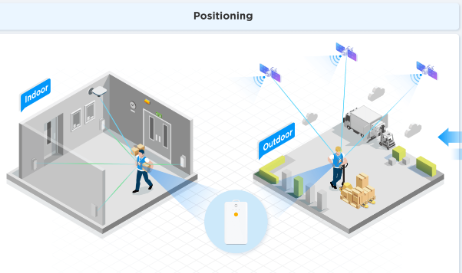In today's era of rapid technological development, positioning and tracking technologies are widely used in various fields. Bluetooth tags and GPS tags, as two common positioning devices, play an important role. Although they are both used for positioning and tracking, there are significant differences in working principles, application scenarios, positioning accuracy, power consumption and cost. Understanding these differences will help us choose the right positioning device in different scenarios.

Different working principles
Bluetooth tags are based on Bluetooth technology and establish connections with surrounding Bluetooth devices (such as smartphones, tablets, etc.) by continuously emitting Bluetooth signals. When the distance between the Bluetooth tag and the device changes, the device can receive changes in signal strength and estimate the location of the Bluetooth tag. It mainly uses the positioning principle of RSSI (signal strength indication), which is similar to the satellite positioning system, except that the "satellite" here is replaced by Bluetooth tags and surrounding Bluetooth devices. For example, a Bluetooth tag will send a secure Bluetooth signal every two seconds, allowing nearby Android or Apple phones to detect, receive, and upload to the server, thereby generating positioning.
GPS tags rely on the Global Positioning System (GPS) and receive signals sent from GPS satellites orbiting the earth through a built-in GPS receiver. The GPS system consists of 24 satellites (usually 21 working satellites and 3 spare satellites in orbit in actual work) orbiting at an altitude of about 20,200 kilometers from the earth. These satellites are distributed on six orbital planes with intersections 60 degrees apart. Four satellites are evenly distributed on each orbit, and the satellites on two adjacent orbits are 40 degrees apart, so that at least four satellites can be seen at the same time anywhere on the earth. After receiving signals from at least 4 satellites, the GPS tag uses triangulation to calculate the three-dimensional coordinates (longitude, latitude, altitude) and time deviation of the receiver, so as to accurately determine its own geographic location information.
Different application scenarios
Bluetooth tags perform well in indoor positioning, short-distance tracking and asset management. In large indoor places such as shopping malls, airports, hospitals, and museums, by deploying a certain number of Bluetooth tags, users can use devices such as smartphones to receive Bluetooth signals for indoor positioning and navigation. For example, in a shopping mall, users can view their location and information about surrounding stores through mobile phone applications and quickly find the store they want to go to. In terms of asset management, enterprises can paste or fix Bluetooth tags on various assets, such as equipment, vehicles, goods, etc., to track the location and movement of assets in real time, optimize asset utilization, reduce rental costs, and prevent asset theft.
GPS tags are more suitable for outdoor long-distance positioning and navigation. In the field of traffic navigation, such as vehicles, ships, aviation, etc., GPS tags can provide all-weather, high-precision location, speed and time information to help drivers plan the best route and improve driving efficiency and safety. In outdoor sports, such as hiking and mountaineering, people can use devices with GPS tags to record their own tracks for easy review and sharing. In disaster emergency rescue, GPS tags can quickly locate the disaster-stricken areas, provide accurate location information for rescuers, and improve rescue efficiency.
Positioning accuracy difference
The positioning accuracy of Bluetooth tags is greatly affected by the environment. In indoor environments, due to the obstruction of obstacles such as walls and furniture, signal propagation will be disturbed, resulting in relatively low positioning accuracy, generally between a few meters and more than ten meters. However, in some optimized indoor positioning systems, by increasing the number of Bluetooth devices and adopting advanced positioning algorithms, the positioning accuracy can be improved to a certain extent.
GPS tags have high positioning accuracy in open outdoor environments, with civil signal accuracy of about 5-10 meters and military signals up to centimeter level. However, in complex terrains such as urban canyons (streets with tall buildings) and mountainous areas, the positioning accuracy may be reduced due to obstructions such as buildings and trees that weaken the satellite signal strength and affect the accuracy of the positioning results.
Different power consumption and cost
Bluetooth tags use low-power Bluetooth (BLE) technology, and the battery life is long, generally up to several years. This makes Bluetooth tags suitable for long-term use, without frequent battery replacement, reducing the cost of use. At the same time, the cost of Bluetooth tags is relatively low and suitable for large-scale applications.
GPS tags need to continuously receive satellite signals and have relatively high power consumption. Although the power consumption of GPS tags is gradually decreasing with the continuous advancement of technology, its battery life is still shorter than that of Bluetooth tags, and batteries need to be replaced or charged more frequently. In addition, the cost of GPS tags is relatively high, especially GPS tags with high-precision positioning functions, which are even more expensive.
There are obvious differences between Bluetooth tags and GPS tags in terms of working principles, application scenarios, positioning accuracy, power consumption and cost. Bluetooth tags have the advantages of low power consumption, low cost, and suitable for indoor short-distance positioning, while GPS tags have the characteristics of high positioning accuracy and suitable for outdoor long-distance positioning. In practical applications, we should choose appropriate positioning devices according to specific needs and scenarios to give full play to their advantages and bring more convenience and benefits to our lives and work.